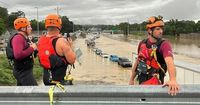Residents of Chattanooga, Tennessee, are reeling after a catastrophic flash flood event on August 12 and 13, 2025, left four people dead, dozens rescued, and hundreds seeking help as heavy rainfall overwhelmed the region’s infrastructure. The disaster, which officials have called one of the worst storms the area has experienced in years, unfolded rapidly, catching many off guard and leaving a trail of destruction in its wake.
The most heartbreaking tragedy occurred just before midnight on August 12, when a large tree—its roots loosened by the waterlogged ground—toppled onto a car traveling along South Moore Road in the Chattanooga suburb of East Ridge. Inside the vehicle were Yuri Tomas Vicente Lopez, 29, Giomara Epifania Vasquez, 27, and their three-year-old daughter, Emma Vicente. All three were killed instantly, according to East Ridge police and the Hamilton County Office of Emergency Management. The fallen tree also brought down several power lines, plunging parts of East Ridge into darkness and knocking out traffic signals at major intersections (as reported by Local 3 News and other local outlets).
Elsewhere in Chattanooga, the storm’s deadly reach extended to East Brainerd Road, where a man lost his life after attempting to bypass fire department barricades. According to Chattanooga Mayor Tim Kelly, the man “unfortunately, unwisely tried to maneuver around fire department barricades and was swept away by a stream.” His body, matching the description of the missing person, was found the following day after an intensive search involving multiple agencies, including the Chattanooga Police Department’s drone unit and the Bradley County Sheriff’s Office K-9 team (FOX Weather and Local 3 News).
These incidents brought the total number of storm-related deaths in the Tennessee Valley to four as of August 13, 2025. The rapid succession of tragedies underscored the severity and unpredictability of the flooding, which was fueled by more than 6.4 inches of rain—about 16 centimeters—falling on Chattanooga in a single day. The National Weather Service confirmed that this was the city’s second-wettest day on record since 1879, with only the remnants of Tropical Storm Lee in 2011 producing more rainfall in a 24-hour period (National Weather Service in Morristown).
The deluge caught emergency services off guard, prompting swift action but also overwhelming resources. Chris Adams, director of emergency management for Hamilton County, described the chaos: “We all know to ‘turn around, not drown,’ but when you look at it and it’s 2 inches deep, and then next thing you know it’s 4 feet deep, that’s something you’ve never seen before.” At the peak of the crisis, more than 940 emergency calls flooded the Hamilton County 911 center between 6 p.m. and midnight, with calls “holding in every minute of every hour for about three hours straight,” said Barbara Loveless, director of operations for Hamilton County 911 (Associated Press).
On the ground, rescue operations were nothing short of heroic. The Chattanooga Fire Department’s swiftwater rescue teams, joined by other agencies, responded to more than 35 rescues—pulling stranded drivers from vehicles, assisting residents trapped in their homes, and even carrying those unable to walk through the rising water to safety. One particularly dramatic rescue involved Troy Plemons, a communications systems technician for EPB, who broke the window of a submerged SUV to save a woman as floodwaters rose to her neck. “I didn’t think there was any time,” Plemons recounted. “I tried my best.” Lawson Electric workers Austin Camp and Brandon Shadwick coordinated with Plemons and authorities, moving between 25 and 35 people to safety. “From babies to seniors, we just kept moving. We didn’t talk to each other. We just worked as hard and as fast as we could to move people to safety,” Shadwick told Local 3 News.
The storm’s impact was felt far beyond individual rescues. Interstate 24, a major artery through Chattanooga, was closed in both directions between Interstate 75 and US 27 due to floodwaters several feet deep. Department of Public Works crews worked overnight to clear basins, remove downed trees, and restore power to affected neighborhoods. The Department of Community Development opened the Chris Ramsey Community Center overnight for more than 20 evacuees, with support from the Chattanooga Fire Department and the Red Cross. Meanwhile, the Wastewater Department responded to four overflow issues and six sewer backups, setting up Storm Station #1 to manage the increased flow (Economic Times, Local 3 News).
The Chattanooga Police Department received 427 service calls during the flooding, including 114 flooding reports, 80 hazard checks, 11 water emergencies, 33 car accidents, and 10 downed wire reports. Chattanooga 311, the city’s non-emergency hotline, handled more than 110 calls, 10 emails, 5 texts, and 25 additional service requests related to flooding. The sheer volume of calls and emergencies reflected the storm’s rare intensity. According to the Tennessee Department of Transportation, the storm had only a 0.2% probability of occurring in any given year—an event that overwhelmed even recently improved infrastructure (Economic Times).
In response to the unfolding disaster, Hamilton County Mayor Weston Wamp declared a state of emergency on the evening of August 12. Touring the hardest-hit areas the following day, Wamp acknowledged the tragic loss of life but noted that, “the property and infrastructure damage was not as bad as I thought it would have been based on the way things looked last night.” Still, the need for coordinated recovery efforts was clear, with officials warning that additional rain and potential flooding could return as the cold front responsible for the deluge lingered over the region (FOX Weather).
The National Weather Service maintained a flood watch for much of Middle Tennessee through Wednesday night, cautioning residents about the dangers of “training storms”—where multiple rounds of heavy rain move over the same area—and urging people to heed the mantra, “Turn around, don’t drown.” The NWS flash flood bulletin emphasized, “Most flood deaths occur in vehicles. Move to higher ground now. Act quickly to protect your life.”
As the floodwaters receded after two to three hours, attention turned to recovery and preparation for the next round of storms. At least one storm shelter was opened at a local recreation center, and officials continued to monitor water levels and infrastructure. Forecasters predicted that after the precipitation departed, temperatures could climb into the 90s, with heat indexes approaching 100 degrees—posing new challenges for residents and recovery crews alike (FOX Weather, National Weather Service).
For many in Chattanooga and surrounding communities, the events of August 12 and 13, 2025, will not soon be forgotten. The rapid rise of floodwaters, the loss of a young family, and the tireless efforts of first responders serve as a stark reminder of nature’s unpredictability and the importance of preparedness. As recovery continues, local leaders and residents alike are left to grapple with both the devastation and the resilience shown in the face of disaster.






